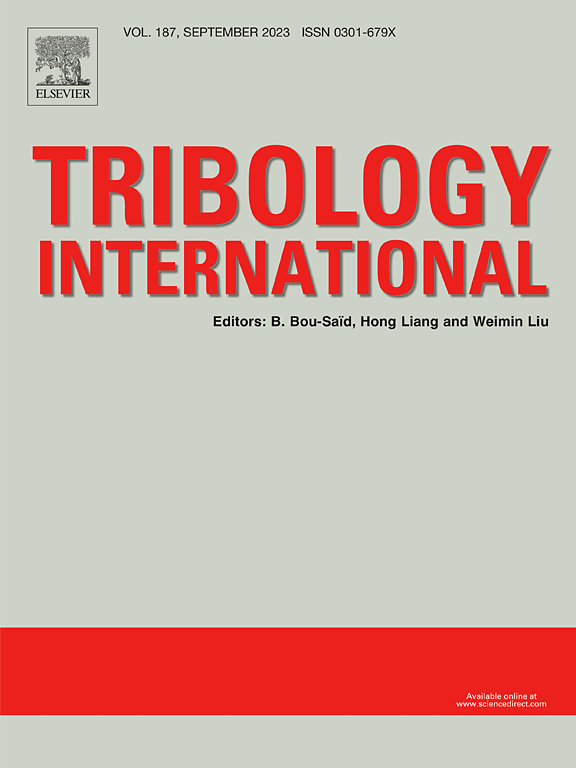Tribo-informatics approach for monitoring the coefficient of friction and its fluctuation in sliding contact based on sound and vibration multi-signals
IF 6.1
1区 工程技术
Q1 ENGINEERING, MECHANICAL
引用次数: 0
Abstract
Monitoring friction interfaces is essential for evaluating system health. However, direct force sensing is often not feasible in real applications. Sound and vibration signals offer an alternative, but their relationship with the coefficient of friction (COF) remains unclear. And most studies focus only on predicting the mean COF and ignore its fluctuation characteristics. In this study, a multi-source acquisition platform was built to synchronously record COF, sound pressure, and bidirectional vibration signals during dry sliding tests. Correlation analysis shows that the fluctuation features of COF exhibit strong correlations with resonance frequencies of sound and vibrational signals, while the mean value of COF lacks clear direct correspondence with these signals. Based on these findings, we propose a two-step prediction method with clear physical meaning. First, fluctuation features of COF (e.g., standard deviation, peak-to-peak, waveform factor) are predicted from sound and vibration features using multiple regression models and ensemble strategies. Second, these fluctuation features are used to predict the mean and root mean square (RMS) of COF through statistical modeling and Random Forest regression. The proposed method achieves high accuracy, over 95 % for most fluctuation indicators and above 98 % for mean and RMS predictions. By separating the modeling of fluctuation and central tendency, this method improves both interpretability and prediction performance. It provides a practical approach for early fault warning and long-term monitoring in tribological systems.
基于声、振动多信号的滑动接触摩擦系数及其波动监测的摩擦信息学方法
监测摩擦界面对于评估系统健康状况至关重要。然而,直接力传感在实际应用中往往是不可行的。声音和振动信号提供了另一种选择,但它们与摩擦系数(COF)的关系尚不清楚。大多数研究只关注平均COF的预测,而忽略了其波动特征。在本研究中,建立了一个多源采集平台,在干滑动试验中同步记录COF、声压和双向振动信号。相关分析表明,COF的波动特征与声音和振动信号的共振频率具有较强的相关性,而COF均值与这些信号缺乏明确的直接对应关系。基于这些发现,我们提出了一种物理意义明确的两步预测方法。首先,利用多元回归模型和集合策略从声音和振动特征中预测COF的波动特征(如标准差、峰对峰、波形因子)。其次,利用这些波动特征,通过统计建模和随机森林回归预测COF的均值和均方根(RMS)。该方法具有较高的准确度,大多数波动指标的预测精度在95 %以上,平均和均方根预测精度在98 %以上。该方法将波动模型与集中趋势模型分离,提高了可解释性和预测性能。为摩擦学系统的早期故障预警和长期监测提供了一种实用的方法。
本文章由计算机程序翻译,如有差异,请以英文原文为准。
求助全文
约1分钟内获得全文
求助全文
来源期刊

Tribology International
工程技术-工程:机械
CiteScore
10.10
自引率
16.10%
发文量
627
审稿时长
35 days
期刊介绍:
Tribology is the science of rubbing surfaces and contributes to every facet of our everyday life, from live cell friction to engine lubrication and seismology. As such tribology is truly multidisciplinary and this extraordinary breadth of scientific interest is reflected in the scope of Tribology International.
Tribology International seeks to publish original research papers of the highest scientific quality to provide an archival resource for scientists from all backgrounds. Written contributions are invited reporting experimental and modelling studies both in established areas of tribology and emerging fields. Scientific topics include the physics or chemistry of tribo-surfaces, bio-tribology, surface engineering and materials, contact mechanics, nano-tribology, lubricants and hydrodynamic lubrication.
 求助内容:
求助内容: 应助结果提醒方式:
应助结果提醒方式:


